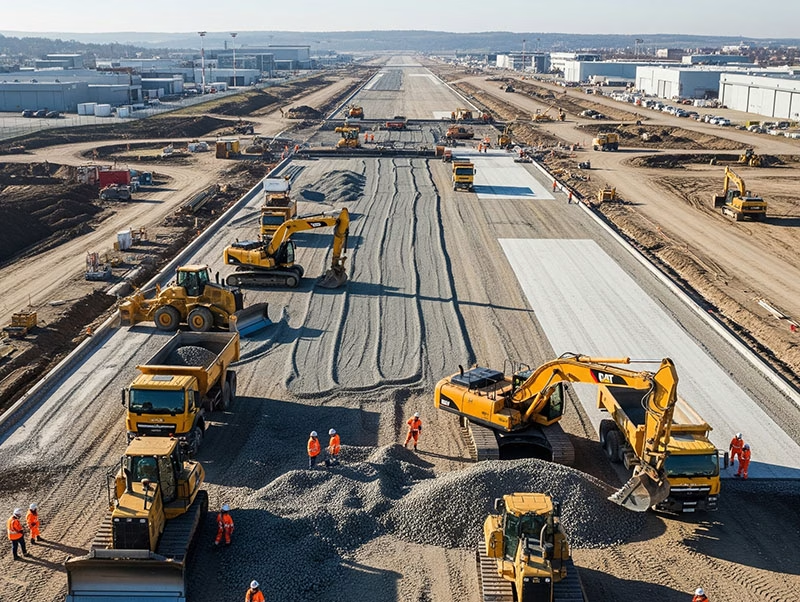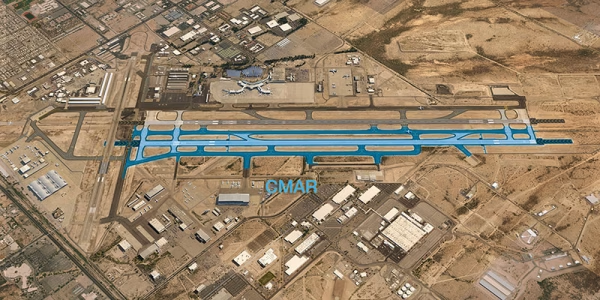Airports across the United States are not just modernizing terminals — they’re also undergoing runway extension projects to handle bigger aircraft, new international routes, and growing cargo operations. These massive runway projects are critical for airports that want to stay competitive in the global aviation market, reduce delays, and safely accommodate larger planes on longer flights.
Here’s a look at some of the largest runway extension projects completed, underway or planned at major U.S. airports right now.
Charlotte Douglas International Airport (CLT)
When the new 10,000-foot Fourth Parallel Runway opens at Charlotte Douglas International Airport (CLT) in fall 2027, it will join three existing north-south parallel runways, boosting capacity and helping manage future air traffic demand with less runway delay. The project also features North and South End-Around Taxiways, improving airfield efficiency and safety by allowing aircraft to move around active runways. The aporport has ben undergoing major upgrading in recent years. The $1.006 billion project is funded through future General Airport Revenue Bonds, Passenger Facility Charge revenue, and federal Airport Improvement Program grants.
Chicago O’Hare International Airport (ORD)
Chicago O’Hare continues its multi-billion-dollar airfield transformation under the O’Hare Modernization Program. One of the biggest elements was the extension of Runway 9R/27L by about 3,000 feet to make it a total of 11260 feet long and 150 feet wide. This project was completed in 2021. It gave the Chicago O’Hare International Airport the distinction of being the airport with the largest number of runways in the world. The longer runway now handles larger wide-body jets and has helped reduce delays during bad weather, and increase capacity at one of the world’s busiest airports. This project is part of O’Hare’s broader goal to add more international long-haul connections and maintain its position as a major hub. American Airlines recently increased the number of destinations flying out of its Chicago hub an indication that the strategy is working.
Denver International Airport (DEN)
Denver International is already home to one of the longest commercial runways in North America — Runway 16R/34L, which is 16,000 feet long. Now, the airport is studying plans for a new seventh runway by 2035 and an eighth runway by 2045. The focus is on boosting capacity for larger aircraft and expanded cargo operations as Denver cements its role as a major connecting hub for both transcontinental and transpacific routes. Planning and design work are underway as part of the airport’s Vision 100 master plan.
Miami International Airport (MIA)
Miami is one of the nation’s busiest international gateways, especially for long-haul flights to Latin America and Europe. To better handle heavy wide-body jets, MIA is advancing plans to extend Runway 9/27 and upgrade its taxiways, drainage, and lighting systems as part of its runway extension projects. A longer runway means more flexibility for fully loaded aircraft in South Florida’s often challenging weather conditions and ensures Miami can continue to grow as a cargo hub and a leading U.S. entry point for global travelers.
Dallas Fort Worth International Airport (DFW)
DFW recently completed a major $260 million rehabilitation of Runway 17R/35L last year. It is 13,400 feet long and now ranks as its longest runway. The airport has future plans for additional runway improvements. Although this recent project focused more on reconstruction than a physical extension, it effectively updated the entire runway surface, extended its lifespan, and upgraded safety areas, deicing equipment, and taxiway connections to handle today’s largest jets under all conditions. The project is part of the airports US$9billion DFW Forward project.
Tucson International Airport (TUS)
Tucson which is a regional airport has taken a big step that could attract new carriers and bigger planes in the future. According to an FAA report effective November 30, 2023, TUS closed runway 11R/29L permanently and began construction of a new south parallel runway. Work is expected to take approximately 2 years, with the new runway anticipated to open in 2026
Why These Extensions Matter
Extending a runway is no small feat. Projects can cost hundreds of millions of dollars and take years to complete. But they’re essential for airports competing for new routes, especially long-haul international and high-capacity cargo flights. Longer runways give pilots more room for safe takeoffs and landings in all weather and help airports reduce delays caused by weight restrictions or short runways.
In many cases, these extensions are also paired with upgraded taxiways, new lighting systems, and modern drainage to meet the latest FAA safety and environmental standards. The push for longer, more capable runways is a sign of how U.S. airports are preparing for the next generation of aircraft — and for a future of growing global travel and trade.
The Big Picture
From Chicago to Miami, Denver to Portland, runway extension projects have shaped how U.S. airports connect with the world. As these massive projects finish over the next few years, they’ll open the door for more flights, bigger planes, and more direct connections for travelers and cargo alike — keeping America’s airports at the forefront of global aviation.



This is poor and inaccurate AI-generated content that was not knowledgeably checked before publication. The cited Chicago O’Hare runway extension was completed in 2021. The cited Portland extension was also completed several years ago. The DFW project was not a runway extension; it was a reconstruction of a runway in its previous existing dimensions. There is presently no runway extension project in Miami.
There is no mention of the only currently active construction of an entirely new runway at a US air carrier airport — Charlotte Douglas International Airport is presently constructing an entirely new runway, which will its fourth parallel runway